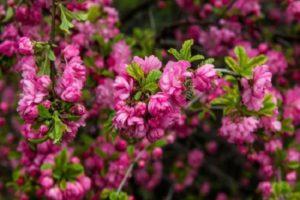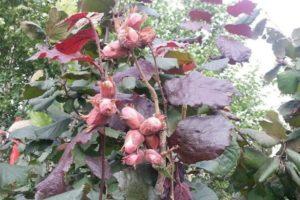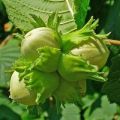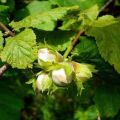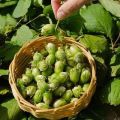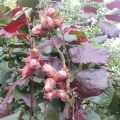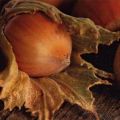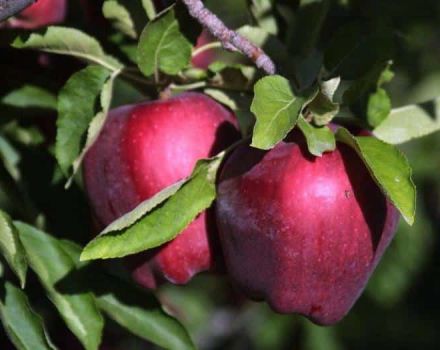Growing and proper care of hazelnuts in central Russia
Hazelnut, one of the useful species of hazel for humans, is widespread throughout southern Russia. There, conditions are most favorable for the growth and development of culture. But it is worth paying attention to the fact that growing hazelnuts in central Russia, caring for them has great potential. Therefore, gardeners who have plots in this part of the country can safely experiment with the cultivation of a cultivated type of hazel.
Is it possible to grow hazelnuts in central Russia
Hazelnut breeding in difficult climatic conditions in the middle zone began to be engaged in the 30s of the XX century. Currently, a large number of hazelnut hybrids have been created, which bloom together and give rich yields of nuts.
Since the new varieties are based on crossing with common hazel, hazelnuts in central Russia are capable of:
- endure low temperatures of winter and spring frosts;
- give nuts with high oil kernels;
- please with high yields;
- become a decoration of the garden area thanks to decorative forms.
Of course, hazelnuts are not as large as in the south, but they have a high nutritional value.

The best varieties for the region
Gardeners in central Russia need to choose only frost-resistant varieties of hazelnuts, among which are:
- Tambov early. The species of hazel with green leaves has been cultivated for a long time. It bears fruit in early to mid-August. The oblong fruits are medium in size and have a thin golden shell. High oil content in kernels - up to 73%. The yield from one tree is 6 kilograms.
- Tambov late. The hazelnut variety is used as a pollinator. The tree bears fruit with medium-sized nuts, oblong-conical in shape and thin shell. The kernels are tender, wrapped, tasty.
- Moscow ruby. The hybrid belongs to the species of hazel with red leaves. Hazelnut bushes are vigorous, productive. One fruit contains up to 7-8 nuts.
- Academician Yablokov. One of the elite varieties with red shoots and leaves. The nuts are large, weighing up to 2.5-3.4 grams, without a ply. Every year, 10 kilograms of nuts are obtained from one bush, which are harvested in September-October. To grow a hybrid, you need a pollinator, which is suitable for the Tambov late and early varieties, Pervenets.
- Firstborn. The variety tolerates winter with frost well.Having an extended flowering period, the hybrid is highly viable. For red-leaved varieties, this is one of the best pollinators.
Depending on the purpose of growing, it is worth choosing hazelnut hybrids that give high yields of nuts or bushes that are decorative.
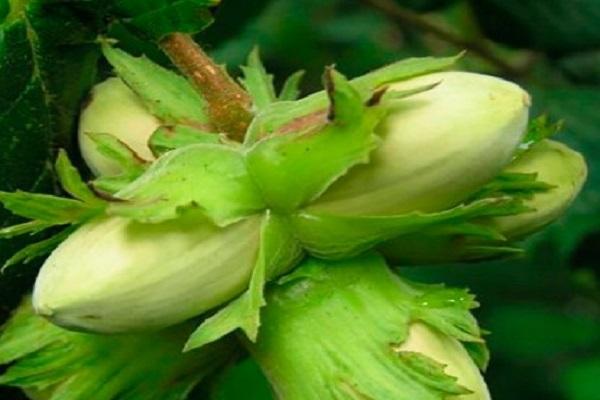
Basic requirements for growing
To grow a nut in your summer cottage, you should pay attention to:
- choose the right place under the tree;
- plant several different varieties next to each other for pollination;
- protect hazel from pests and diseases.
Agrotechnical measures must be carried out competently and in a timely manner, then hazelnut cultivation will be successful in central Russia as well.
Timing and site selection
For regions with early and cold winters, it is optimal to plant walnut trees in the spring. They are planted in April before the sap flow begins.
The site should be prepared for hazel in advance. We need fertile, well-watered soil. But wetlands with close water occurrence cannot be used.
Shrub grows better in well-lit places. It is necessary to protect the planting from drafts, cold winds. Trees grow well near the wall.

Preparation of planting material
The shrub will take root better if the seedling is:
- without leaves;
- with 3-5 developed shoots;
- have a developed root system with a root length of half a meter;
- with a trunk thickness of 1-1.5 centimeters.
Do not forget to prepare and plant 2-3 different varieties of hazelnuts next to each other.
Landing
You can plant hazelnuts both by seeds and using ready-made seedlings. The first method is most often needed for breeding work. When using seeds, it is more difficult to maintain the varietal characteristics of the crop. Yes, and the hazel begins to bear fruit later, if it is planted with seed.
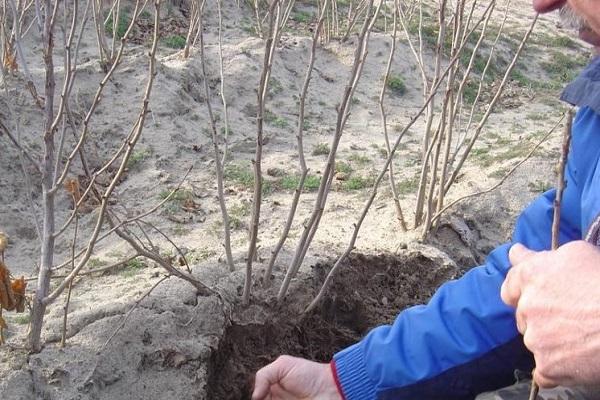
Seeds
Only ripe nuts are chosen for planting in the garden. They should not be spoiled, without a moldy smell. First, the nuts are kept in water for 5 days. Nutrient soil is poured into the boxes and nuts are placed there. They must undergo a stratification procedure at a temperature of 2-6 degrees Celsius. It is worth starting seed preparation in May, because it will take 2-3 months.
Then the sprouted nuts are ready to take root in a permanent place in the garden.
Vegetative way
It is more convenient and easier to plant hazel seedlings. A month before planting, a pit 60 centimeters wide and long is prepared. A layer of a mixture of peat or humus with earth and superphosphate is poured into it. A mound of garden soil is made from above. They put a nut tree in the middle, straighten the roots. It is better to dip the hazelnut roots into a clay mash and trim slightly.
The roots are covered with nutritious soil, slightly shaking the tree so that the earth is evenly distributed between the roots. A peg is placed nearby for tying hazel. At the end of the procedure, abundantly planted walnut bushes are watered.
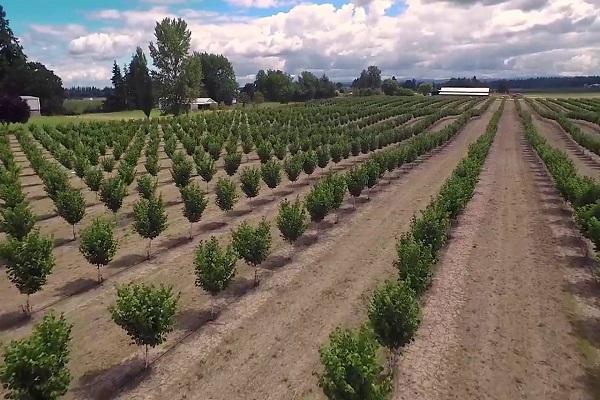
For farmers, planting hazelnuts in nests is suitable. With this method, 5-6 bushes are planted in a circle according to a 6 x 6 meters pattern. All branches from the root are removed before planting. So the hazelnuts will grow into 1 trunk.
It is impossible to deepen the roots strongly during planting.
Further care of the culture
In order for a culture to grow and develop rapidly, it should be properly cared for. Timely watering, feeding and pruning will allow the tree to gain strength and please with a rich harvest of hazelnuts.
How to water
When forming hazel, it is necessary to water the plantation abundantly. So a week after planting, young trees are watered. Then, during the season, moistening is carried out when the earth from above begins to dry out.
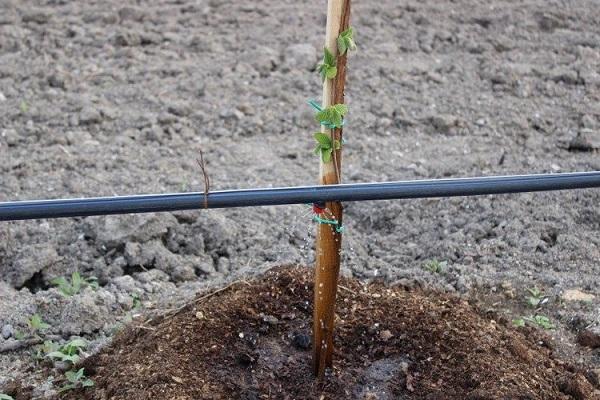
Mulching is used to retain moisture. A layer of sawdust or needles is poured around so that they do not come into contact with the hazelnut trunk.
Fertilizer
For feeding hazel, organic and mineral nutrient solutions are used.After planting, it is best to water with a slurry solution diluted in a ratio of 1:20.
Every year they begin to apply fertilizers to the ground after 3 years after planting. Before that, hazelnuts are fed with what is in the ground. In the spring, nitrogen fertilizers are introduced every 2 years.
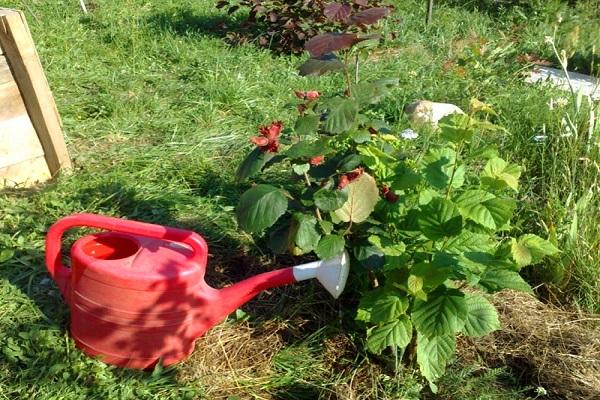
How to care during flowering
Hazelnuts begin to bloom and bear fruit in the 4-6th year after planting. But if three-year-old trees are planted, then the waiting period for nuts will be reduced.
To set fruits during the growing season, a nut is required:
- feeding with potassium and phosphorus;
- introduction of humus into the trunk circles together with nitrofoskoy;
- moderate watering;
- termination at the time of loosening the soil.
To better lay the nuts, pruning is needed. It is carried out in the spring, rejuvenating the tree, and in the fall.
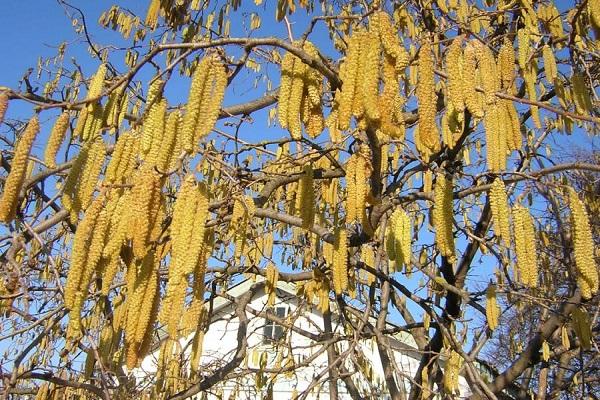
Pruning
To obtain a bountiful harvest, pruning should be started, which is carried out in a timely manner. Excess shoots should be removed constantly, otherwise the hazelnuts will grow and bear fruit poorly. In the spring, viable young shoots are left, shortening them by a third. During the fruiting period, the walnut tree constantly requires renewal.
In autumn, cut off old shoots, dried and diseased branches. It is also necessary to thin out the middle of the bush.
Wintering hazel
Despite the winter hardiness of varieties for central Russia, they need a nonwoven cover for the first 3 years of life. Planting should be protected from heavy snowfalls in winter by bending the branches to the ground and pinning them. From above, young trees are covered with spruce branches of coniferous trees. Hazelnuts tolerate winter well if they are watered abundantly and fed with wood ash in October.
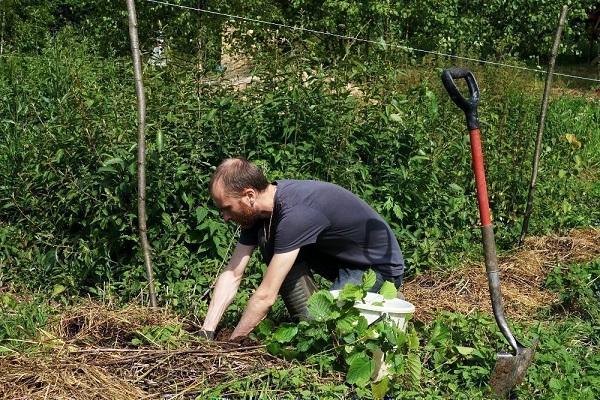
Protection against diseases and pests
One of the common diseases in hazel is powdery mildew. Less often, the tree is damaged by brown spot. Treatment of plantings with a solution of copper oxychloride in 0.3% and Bordeaux liquid in 1% helps against infection. Powdery mildew is effectively treated with preparations containing sulfur.
Of the pests, the hazelnut plantation is harassed by the nut weevil, leaf beetle, hazelnut barbel... They are driven out, destroyed by spraying with "Decis". The solution of "Karbofos", "Fozalon" helps from hazel aphids. Occasionally, you can see thin cobwebs entangling hazel foliage. This is a spider mite parasitizing on hazelnuts. It can be dealt with with sulfur preparations, chloroethanol solution.
Reproduction
There are several ways to breed hazelnuts. Reproduction is more successful in a vegetative way, although the seed method is also used.

Taps
This method of reproduction is simple, since it is not necessary to separate the shoots from the mother bush. Near the hazelnuts, you need to dig a trench half a meter long and 15 centimeters deep. The side branches are laid in grooves, pinned to the ground. The upper part of the shoot is taken out and tied to pegs. It remains to cover the trenches with earth. After abundant watering, the soil will be compacted and the branches will be able to form roots.
To get several branches, and not one, in autumn or spring, annual shoots should be bent to the ground and left without sprinkling. Roots will appear from the buds, from which shoots will rush upward. When they reach 10 centimeters, they are huddled. As it grows, the procedure is carried out twice more. Then the horizontal shoot is completely excavated, cutting it into pieces. Each should have a vertical sprout.
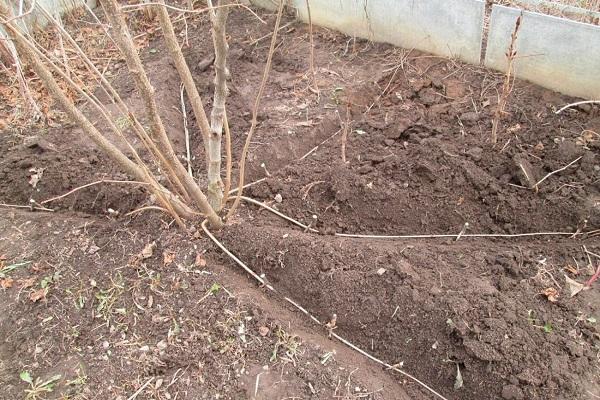
Offspring
In the 2-3rd year after planting, hazelnuts form a growth from the rhizome. It is used for breeding varietal hazel. Lateral branches are freed from the ground and separated from the mother bush with an ax or pruning shears. It is essential that each offspring has a strong and healthy root with buds.
Vaccination
A difficult method is used by experienced gardeners. Hazel seedlings act as a stock for hazelnuts. Most often they use common or variegated.A bear nut is also suitable for grafting or its hybrids with hazelnuts.
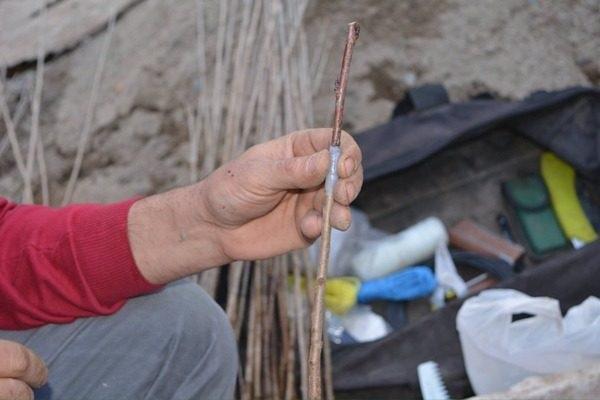
By dividing the bush
A simple method can be used even by novice nut growers. Hazel is dug up and divided into several parts. Each of them should be 15-20 centimeters high with a hemp. Pay attention to the development of the root system.
Harvesting and storage
Hazelnuts are harvested after the nuts have ripened. They are placed under a canopy for drying and fermentation. The layers should be systematically turned over so that they do not rot and deteriorate. Nuts are stored for a long time if they are placed in a room with a temperature of 0-2 degrees Celsius and a humidity of 70%.
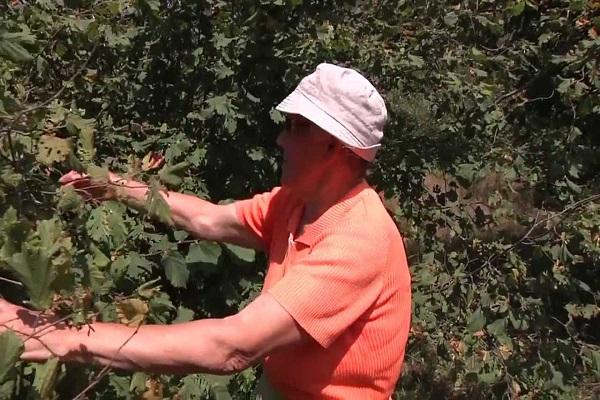
Decorative forms of hazel
Ornamental hazel can be used to decorate the landscape. Among the varieties of this purpose are:
- purple-leaved hazel with flaming leaves;
- fern-leaved with carved, like oak leaves;
- variegated varieties with a yellow, white border or spots on the green surface of the leaf;
- grade Ivanteevskaya red with excellent winter hardiness;
- hybrid Purple F-86.
These forms of hazelnuts do not bring rich harvests, but they will decorate the site all summer until autumn. They are used to create hedges or singly on the lawn.
